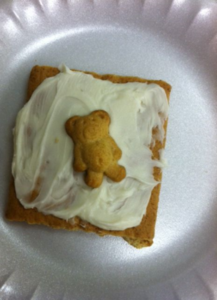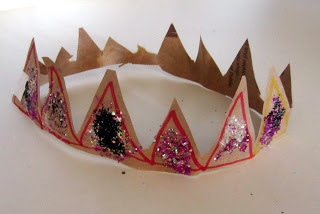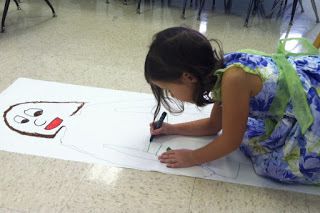Rebecca S. Ramsey's Blog, page 5
January 31, 2022
The Parable of the Loving Father
 Welcome to The Parable of the Loving Father, the story Jesus tells in Luke 15: 11-32.
Welcome to The Parable of the Loving Father, the story Jesus tells in Luke 15: 11-32.
What an important lesson to teach our children, that nothing can separate us from the love of God. (Romans 8:38-39!) The world is full of hurting people who need to hear this, don’t you think? Who hasn’t made mistakes and felt out of the circle– and who hasn’t also felt a tinge of resentment when someone not playing by the rules gets a free ride? (Or maybe that’s just me!) Awareness of God’s grace is so important to our kids. It’s a perfect discussion topic for this week.
If you’re one of our Sunday school teachers at FBC Greenville, you will receive an email with the script included. Let me know if you didn’t get it or have trouble opening it and I’ll see if I can fix the problem. (If you’re at another church and would like to use the script, send me an email and I’m happy to send it to you. Or join this site and get this script and 9 others.)
The parable is in a gold box (after all, it’s a parable!) in your Sunday school rooms, ready for you.
Now, how can we help the children deepen their exploration and understanding of the story through their art response time? What ideas can serve as springboards for their own creativity in making a gift for God?
Starter Ideas for Art Response
(Called “Starter Ideas” because this isn’t your grandmother’s craft time. We hope to give the children germs of an idea and then let them take it where they want to take it! Children respond on a much deeper level when they contribute their own ideas to their responses.)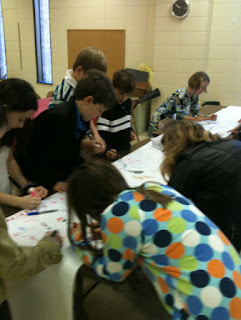
1. Have a celebration feast, just like the father threw for the son, celebrating God’s special kind of love. The kids could decorate cookies–or here’s something corny… eat pigs in blankets–reminding them of the pigs the son took care of. You could eat at the end and spend the first few minutes making it really special, letting the children make have decorations for the table-like a tablecloth full of love messages to God. Candles on the table would be nice. And as you prepare, you could help the children remember what the feast is all about: honoring God, who loves us and welcomes us back to him, no matter what we do, no matter if we misbehave or if we stick so closely to the rules that we miss the whole point of love all together.
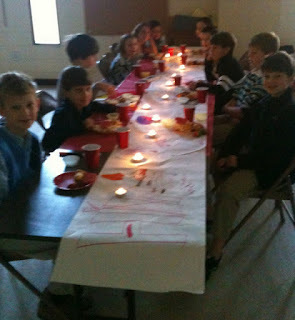 I’m glad to reimburse you for any supplies you need to buy. Just bring me a receipt (with only Sunday school purchases on it) and I’ll make sure you’re repaid quickly.2. Put a small mirror in a craft store frame which each of the children can decorate, writing on it with Sharpies something like God loves me exactly like I am. Children could decorate the frame however they like, by gluing on sequins or foam shapes, by using glitter glue or whatever supplies you have on hand.
I’m glad to reimburse you for any supplies you need to buy. Just bring me a receipt (with only Sunday school purchases on it) and I’ll make sure you’re repaid quickly.2. Put a small mirror in a craft store frame which each of the children can decorate, writing on it with Sharpies something like God loves me exactly like I am. Children could decorate the frame however they like, by gluing on sequins or foam shapes, by using glitter glue or whatever supplies you have on hand.We have a few of these frames in the resource room. If you give me a call before noon on Thursday, I can let you know how many we have and put them in your room for you.3. Children could make cards for Meals on Wheels and for our folks in the hospital or in nursing homes. I’d be glad to see that they get to those who need them.4. Some children might enjoy acting out the parable. If you can video it, send it to me and I’ll share it.5. Older children might be interested in taking a look at the much loved hymn Amazing Grace. They could illustrate it –or record themselves singing it. Let me know before Sunday if you need a recorder.6. I bet the children could be really creative if you ask them to make a valentine for God, however they want, however big or small, whether 2 dimensional or 3 dimensional (clay maybe?)
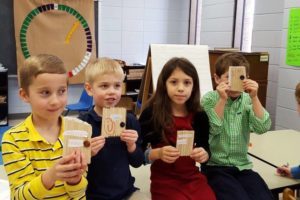 4. Why not make a door out of popsicle sticks, with the sign on it that says, “Welcome Home!” That’s a great reminder of the father who waits, ready to welcome home his son no matter what he’s done.
4. Why not make a door out of popsicle sticks, with the sign on it that says, “Welcome Home!” That’s a great reminder of the father who waits, ready to welcome home his son no matter what he’s done.
For more art response ideas, see my Pinterest board on the parable, here.
Love, Becky
The post The Parable of the Loving Father appeared first on beckyramsey.info.
January 10, 2022
Jesus Heals a Paralyzed Man
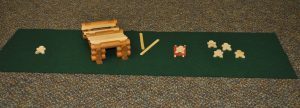 Welcome to Jesus Heals a Paralyzed Man, based on Luke 5:17-26.
Welcome to Jesus Heals a Paralyzed Man, based on Luke 5:17-26.
It was really fun to think about how to tell this story, how to create the house so that the friends could deliver their paralyzed friend to Jesus’s feet. It was also a pleasure to think about the lesson itself: what happened that day and what we can learn from it about faith, the power of Jesus, (and his ability to heal both wounds of the spirit and physical wounds) and what it means to be a Christian friend.
As you can see from the scripts, I’ve written the story in two versions: one for the younger children, which focuses on the healing itself and on friendship, and one for older children, which also includes the discussion after the healing between Jesus and the religious scholars. There is an added wondering question for the older children concerning this discussion as well.
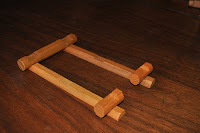 As you tell the story, you will find enough Lincoln logs in your basket to build the house as shown below. I’m hoping to have enough donated so that you can be creative and build it how you like, but just in case you have to go with the blocks I’ve got, I’m sharing a pictorial guide to building it here.
As you tell the story, you will find enough Lincoln logs in your basket to build the house as shown below. I’m hoping to have enough donated so that you can be creative and build it how you like, but just in case you have to go with the blocks I’ve got, I’m sharing a pictorial guide to building it here.
If you like, as you build the house you could remind the children of last week’s story about Jesus calling Levi (Matthew), that some of the most important work Jesus did was done while visiting people in their homes, listening to them, talking with them, teaching them, bringing them peace, and often healing them in different ways.
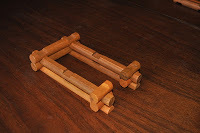
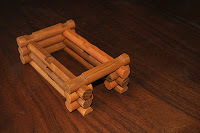
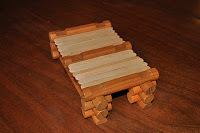
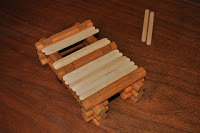 Once the house is built, you can begin the story.
Once the house is built, you can begin the story.
The popsicle stick roof makes it easy to remove “tiles” so that the paralyzed man can be lowered. You may want to take off all of the tiles and part of a side wall so that everyone can see what is going on inside the house. Or just demonstrate the lowering, and then tell the rest of the story on the green underlay.
If you’re teaching the older children, as you talk about Jesus’s discussion with the religious scholars, you will want to stress that people may have thought that sin was connected to illness in Bible times, but that this is untrue. Children sometimes mistakenly pick up only parts of a sentence, and the idea that illness has anything to do with sin is definitely one we don’t want them to get!
We can celebrate that there were actually two miracles shown by the story: that of healing the paralyzed man and that God empowered Jesus to heal the heart of the man, forgiving him of his sin. None of it would have happened if it hadn’t been for the man’s friends, who loved him enough to do whatever it took to get him to Jesus.
Gift – To – God Ideas
The story is probably enough to inspire the children to express it through their very own artistic gift to God, but just in case they need a little springboard, here are some ideas I hope will be helpful.
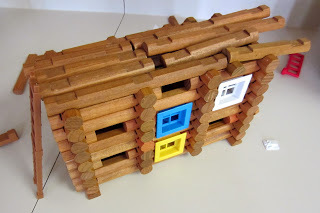 1. Let the children act/play out the story:
1. Let the children act/play out the story: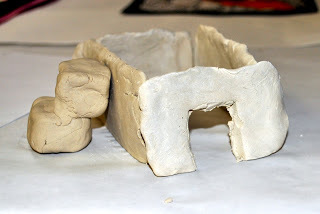
(Encourage them to retell the story to each other, not just build the house.) I hope to have enough extra Lincoln logs to add to those in the story basket. We’ll see.
*Pick characters and act it out. Bring a blanket and let them try to lift one person in the blanket (over the carpet, and not very high,:) )
2. Make parts of the story.
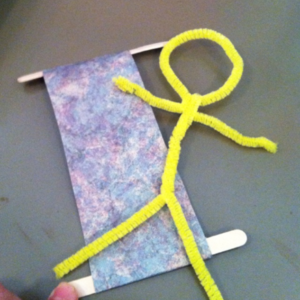 * Make a mat with fabric and Popsicle sticks and a man and his friends and Jesus from clothespins. Bring shoe boxes and let the kids make a
* Make a mat with fabric and Popsicle sticks and a man and his friends and Jesus from clothespins. Bring shoe boxes and let the kids make a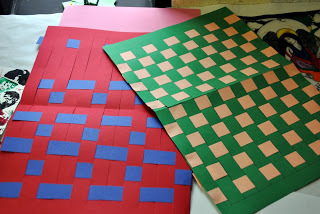 whole set, with the house too. Can they make a set of stairs leading up to the roof? (See an example of something sort of like this here.
whole set, with the house too. Can they make a set of stairs leading up to the roof? (See an example of something sort of like this here.
*Weave a mat as shown here. When the kids can use it at home as a placemat, it will remind of the story. All it takes is construction paper.
3. Make a collage about what it means to be a (Christian) friend. Cut out pictures from magazines that show people being friends to each other or draw pictures that show friendship in action. This could also be a great mural that the whole class works on together.
4. Make a Person-on-a-Mat snack. Frost graham crackers with icing, and arrange stick pretzels and marshmallows to form the body of the person on the mat. Or you could use gingerbread men. (Who would turn down frosting?!)
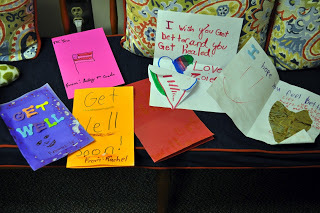 5. Cards for others. We might not be able to heal others, but cards with pictures and friendly messages can help aid the healing. Offer kids the option of making get well cards for church members or shut ins.
5. Cards for others. We might not be able to heal others, but cards with pictures and friendly messages can help aid the healing. Offer kids the option of making get well cards for church members or shut ins.
For more art response ideas, see my Pinterest page here.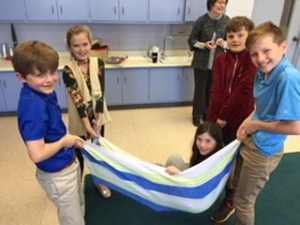
I hope you enjoy the story.
Love, Becky
The post Jesus Heals a Paralyzed Man appeared first on beckyramsey.info.
November 15, 2021
Jonah, the Backward Prophet
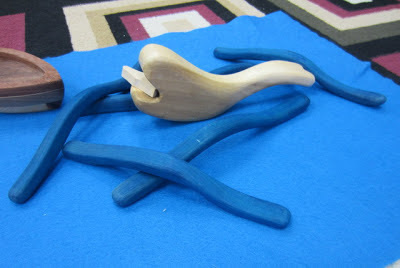 Welcome to Jonah, The Backward Prophet, the Godly Play story found in the orange Volume 2, The Complete Guide to Godly Play, 14 Presentations for Fall book on p.107-113.
Welcome to Jonah, The Backward Prophet, the Godly Play story found in the orange Volume 2, The Complete Guide to Godly Play, 14 Presentations for Fall book on p.107-113.
This story fits within the larger story of the Exile and the Return that we recently shared. I’m sure the children will enjoy the message of this favorite: how God constantly reaches out to people-and even to his prophet- no matter if they seem to do everything the wrong way. God is always calling us to God’s self, trying to save us from ourselves and from sin that hurts us.
As in the story of Elijah, it is important that we focus on God’s saving nature rather than focusing on God as the One who sends storms. With the hurricanes and tsunamis and earthquakes in the news, hurting people all over the world, we certainly don’t want children to get the idea that God is the author and sender of such pain and suffering. (As in the story of Elijah, God was not in the wind, God was not in the earthquake- God was in the still small voice…)
Idea Sparkers for our Make a Gift for God Time:
1. Recreate the story in some way.
a. Could your children make parts of the story? Someone make a boat, another a whale, another the plant, the waves, another Jonah. Put them all together and take a photo, please!
b. Each child could make a depiction of Jonah in the whale, like the one shown here. I’d just recommend that you encourage each child to invent his/her own way of making this, rather than having them all done the same way. The children will think of all sorts of creative ways to do it. You could even take them into the resource room and show them lots of options. They could make the whale out of a milk jug, as shown here. (Scroll down) Or out of paper plates, as shown here. Or out of a paper bag as shown here.
c. Celebrate the story with a snack, as long as you’re following Covid procedures to keep everyone as safe as possible. (One gloved adult serves individual servings-rather than kids serving themselves, etc) Here are some ideas:
1. Goldfish crackers (I’ll have some if you want them)
2. Make a snack boat. Put blue frosting on a graham cracker to represent the sea. Cut an apple into wedges for a boat to stick on the sea. Make a cheese sail and attach to the boat with a toothpick. Have any ideas for Jonah? (I won’t have these items so you’d need to bring them.)
3. Make whales with individual egg carton sections.
4. Watch the video of the child telling the Jonah story below.
https://www.youtube.com/watch?v=Z4VrujheblY
5. Let the children retell the Jonah story with the Godly Play materials and video them.
6. I’ll have several Jonah books from the media center in the Children’s Activity Room. Feel free to take them to your classroom. Just return them please, when you’re done.
For more art response ideas, check out my Pinterest page, here.
Enjoy the story, y’all! Thanks for what you do!
Love, Becky
The post Jonah, the Backward Prophet appeared first on beckyramsey.info.
November 8, 2021
The Story of Daniel
Hi Godly Play Teachers!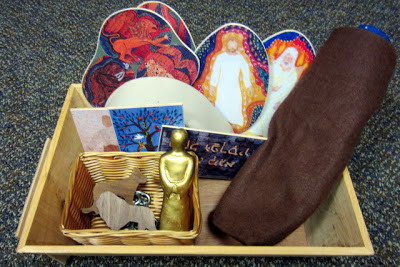 Welcome to The Story of Daniel. You can find the script in the pink Volume 6, The Complete Guide to Godly Play, 15 Enrichment Presentations for Fall book on p.116-125.
Welcome to The Story of Daniel. You can find the script in the pink Volume 6, The Complete Guide to Godly Play, 15 Enrichment Presentations for Fall book on p.116-125.
Daniel’s life story provides children with so many themes to discover, each of them so important, including:
*the importance of living a life faithful to God
*the assurance that God will be close to God’s people forever
*if we ask for it, God will give us the courage needed to follow God when it goes against what the world values
*we can question God about the things we don’t understand
*God can sustain us in times of despair and give us hope.
As the children work during their response time, we can give them chances (by asking questions) to talk about these themes. It’s so important that the children don’t just walk away from Sunday school with a lion or a fiery furnace, but their own ideas of how the story applies to them.
Idea Sparkers For Our Give A Gift to God Time
1. Reproduce the story in some way.
Of course the BEST ideas for art response time come from the child herself, but here are some ideas to get our kids thinking. Hopefully they won’t follow anyone’s set of instructions verbatim, but will make something all their own.
There are plenty of directions out there for making artistic representations of Daniel in the Lion’s Den.
1. Here’s one of my favorites, a den of lions and a Daniel, all out of paper cups.
2. There’s a cute lion out of noodles, here, and other lion ideas here.
3. There’s a whole host of Daniel craft ideas here.
4. There’s a paper plate lion here.
5. Children could also make the fiery furnace scene. I found 3 good sites for this, here, here, and here.
2. You could also focus on God’s gift of courage- like the kind Daniel had- by making a bracelet celebrating courage like the ones here.
3. You could celebrate Daniel’s life by making a mural with all the scenes from the story.
4. Our Godly Play Daniel story leaves out the story I remember from my childhood: the part at the beginning, when Daniel was first taken captive to Babylon and asks permission to eat food other than that on the king’s table. You might want to present the story as scripted, and then ask the children if they know the part left out. The children could find it in the Bible (Daniel chapter 1) and figure out how to make it part of the Godly Play story. How would they tell that part of the story? What figure or drawing could they add to the story basket? What does this part of the story have to do with them (and not just about what kinds of food they eat!)
Find more ideas about responding to the Daniel story at my Pinterest Page here.
I hope these ideas help!
Love, Becky
The post The Story of Daniel appeared first on beckyramsey.info.
November 1, 2021
The Exile and the Return
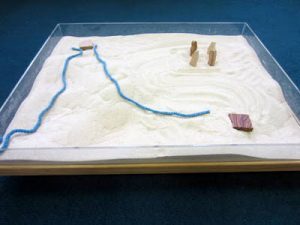 Hi Godly Play Teachers!
Hi Godly Play Teachers!
Welcome to the Exile and Return, the Godly Play story found The Complete Guide to Godly Play, Vol. 2, (the orange fall book.)
Last week we shared the story of the ark and the temple, and talked about meeting God in a special place and honoring him with certain routines that both honored God and helped remind the worshipers of the sacredness of being close to God.
At the end of the lesson, we read Solomon’s prayer of dedication of the Temple, where he prays, “But God, will you really live here with us on earth? The whole sky and the highest heaven cannot contain you. Certainly this Temple that I built cannot contain you either…” This week, we think about this again as we learn about what happened when God’s people were taken away from Jerusalem and its temple, which they had believed to be God’s home.
Some themes to explore:
Where do we find God? What if we suddenly have no temple or tabernacle or special routines or things to honor God? Can we still meet God?What do we do when we’re very afraid, when bad things happen to us? What do we pray for? What does God want us to do?What does it mean to be homesick? What were God’s people homesick for during the story? Were they homesick for God?What changes have you been through that have been hard or scary for you? What did you do? Who gave you help? What should we remember when those times come?What does it mean to be faithful? How is it different to be faithful in hard times versus in easy times?Some activity ideas to add to your own, to help children make a gift to God in thanks for the story:
Reproduce the story.
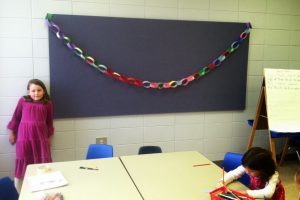 Children could make their own physical elements of the Godly Play story, with blue yarn for the rivers. (Or maybe they can think of another way to represent them.) Pieces of wood for the cities. Can they make a chain out of pipe cleaners or strips of paper? (While they do this, teachers can talk about what the chain means–what it means to be in exile.) What could they use to make the people of God?They could draw or paint with watercolors a scene from the story: the destruction of the temple, the sad journey away from Jerusalem, the happy rebuilding of the temple.Older children could use markers to trace the path of God’s people on a photocopied map. Could they make a map of their own? One for the class
Children could make their own physical elements of the Godly Play story, with blue yarn for the rivers. (Or maybe they can think of another way to represent them.) Pieces of wood for the cities. Can they make a chain out of pipe cleaners or strips of paper? (While they do this, teachers can talk about what the chain means–what it means to be in exile.) What could they use to make the people of God?They could draw or paint with watercolors a scene from the story: the destruction of the temple, the sad journey away from Jerusalem, the happy rebuilding of the temple.Older children could use markers to trace the path of God’s people on a photocopied map. Could they make a map of their own? One for the class
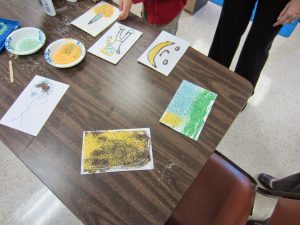 Children could use colored sand to make a desert scene.
Children could use colored sand to make a desert scene.Explore themes from the story.
Children could take a large sheet of paper, divide it down the center into 2 parts, label the left side Times We Are Sad Or Scared, and the other side What We Can Do. Then the children can draw or paint pictures to illustrate both sides.Children could draw or paint or do a collage on the subject of Where and When I Meet God Today. Is it in nature? In church? At home reading the Bible? Being with friends? This would be a great addition for our new bulletin board. This could also be done as a class project on butcher paper (like a mural.)What does it mean to be faithful? Children could make a collage or drawing or mural showing what it means to be faithful to God. Does it mean coming to church and worshiping together? Bringing an offering? Praying? Trusting? What else?Children could draw or write about a time they were homesick. What helped them get through it? What would God want us to do when we feel homesick?Some great verses to get children thinking:
“We sat down and cried by the rivers of Babylon when
we remembered Zion. How can we sing the song of the
Lord in a strange land?” (Psalm 137:1, 4)
“Praise the Lord, all nations! Praise Him all people! For
His loving-kindness toward us is great. And the truth of
the Lord lasts forever. Praise the Lord.” (Psalm 117)
See my Pinterest page for the story here for more ideas. [image error]
Enjoy the story!
Love, Becky
The post The Exile and the Return appeared first on beckyramsey.info.
October 25, 2021
The Ark and the Temple
Welcome to the Godly Play story The Ark and the Temple, found in The Complete Guide to Godly Play, Volume 2. (The orange book.)
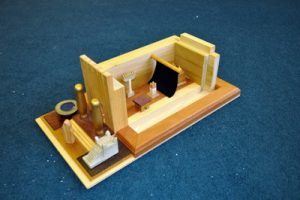 For a girl who could spend days moving furniture and little people around a dollhouse, I simply adore this lesson! I also love it because it explores the idea of God’s abiding presence and helps us question exactly where God is. Where can we meet God? If it is in a church or temple, how do we keep that space sacred? If God truly meets us everywhere, anywhere, then what does that say about the sacredness of the space we occupy in our everyday lives? Which makes me think of a favorite song of mine, but that’s another story. (Go here, if you want a treat!)
For a girl who could spend days moving furniture and little people around a dollhouse, I simply adore this lesson! I also love it because it explores the idea of God’s abiding presence and helps us question exactly where God is. Where can we meet God? If it is in a church or temple, how do we keep that space sacred? If God truly meets us everywhere, anywhere, then what does that say about the sacredness of the space we occupy in our everyday lives? Which makes me think of a favorite song of mine, but that’s another story. (Go here, if you want a treat!)
This story works wonderfully as a continuation of The Ark and the Tent, and then Ruth and David’s stories. Before, the people took the tent with them as they traveled, and learned that God goes with them wherever they go. Now, the people have settled and learn that God is not only present during times of transition but in ordinary times of daily life.
Another interesting theme to address is the idea of the usefulness of things in the worship of God. When the ark and the commandments were taken during battle and they didn’t physically have them in the tent, were they really lost? When King David returned them, dancing into Jerusalem, what was he really celebrating?
Another very important theme to cover is that there is no physical place that can contain God. I’ll have Solomon’s temple dedication prayer typed up and in your room by Wednesday night this week. If you’d like to make it into a scroll to read during the lesson, as the script suggests, feel free. I believe we have some dowel sticks in the resource room. Balling up the paper and staining it with tea makes it look older and makes for a more dramatic presentation, if you like.
One other thing I didn’t mention before was the idea of making/offering sacrifices. Do we still offer sacrifices to God today? What kinds of sacrifices would God love? What kinds are important and why?
I wonder if a trip to our own sanctuary might be interesting to the children, after they study the temple. What is alike and what is different? What kind of sacrifices do we still make? Is there a way we make ourselves more acceptable to God before entering?
Some activity ideas to help the children get started:Pieces of the temple
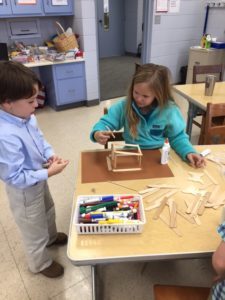 A few of the classes began a few weeks ago making special parts of the temple/tent. You could continue that this week, and you could even set up the items in a temple of your own making. Kids could make an ark, the ten commandments, a table with 12 pieces of bread, a menorah, a laver, and an altar. (See all the ideas and photos here.)
A few of the classes began a few weeks ago making special parts of the temple/tent. You could continue that this week, and you could even set up the items in a temple of your own making. Kids could make an ark, the ten commandments, a table with 12 pieces of bread, a menorah, a laver, and an altar. (See all the ideas and photos here.)
Could we make edible versions of all these things? And then make an edible temple? See my Pinterest site here, for ways to do this. [image error]
Make a temple
Could we make a temple out of a shoe box? (There are several in the art resource room. Help yourself! ) Or maybe draw a temple? Make one out of Lego?
Make a scroll with Solomon’s Prayer
Depending on the age of the children, you could have them copy the prayer (or use a pre-printed version), ball it up and then smooth it out, dye it with tea, and attach dowel sticks.
Research and draw/paint a priest in Solomon’s temple
I’ve got a good book that illustrates the kinds of garments priests of that time wore. Some children might enjoy discovering that and reproducing it in some way.
Enjoy the story!
For more art ideas, check out my Pinterest page, here.
Love, Becky
The post The Ark and the Temple appeared first on beckyramsey.info.
October 17, 2021
The Psalms
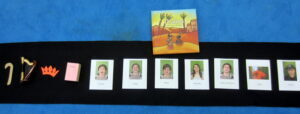 Welcome to The Psalms, the Godly Play story scheduled for this Sunday, November 10, based on the book of Psalms.
Welcome to The Psalms, the Godly Play story scheduled for this Sunday, November 10, based on the book of Psalms.
If you’re teaching at FBG, I’ve emailed you the story script, which includes the first part of the David story from last week, found in the pink Enrichment Presentations for Fall, p.81. If you are not a Sunday school teacher at First Baptist Greenville and would like a copy of the Psalms story script, just email me and I’d be happy to send it to you. Or join the blog mailing list and it will be sent to you, along with 9 other Godly Play style story scripts that I’ve written and am happy to share.
In the script, we use the first part of the David story and then explore the idea that the Psalms writers went to God with all kinds of different emotions. We discuss how we can pray to God when we feel afraid, happy, angry, peaceful, sad or worried, and joyful, or when we feel sorry for what we’ve done. With each different emotion, we share a Psalm (or 2 or 3) that the Psalm writers experienced and shared with God.
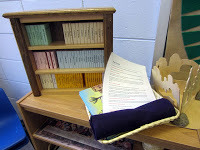 To share the Psalms, we’re going to use a beautiful book, Psalms for Young Children, written by Marie-Helene Delval and illustrated by Arno. In this book, Ms. Delval has adapted the psalms for children in a way that is so easy to read and to relate to. I’ve purchased one for each class (except for 3rd grade, which already had a copy.) You’ll find it in your story basket, which I left near your Bible bookcase. I put it there to remind you (and me) that you’ll need the Bible Bookcase as you tell the story. (You’ll take the Psalms book out and place it on the underlay in part of the story.
To share the Psalms, we’re going to use a beautiful book, Psalms for Young Children, written by Marie-Helene Delval and illustrated by Arno. In this book, Ms. Delval has adapted the psalms for children in a way that is so easy to read and to relate to. I’ve purchased one for each class (except for 3rd grade, which already had a copy.) You’ll find it in your story basket, which I left near your Bible bookcase. I put it there to remind you (and me) that you’ll need the Bible Bookcase as you tell the story. (You’ll take the Psalms book out and place it on the underlay in part of the story.
By the way, the Psalms in this book are shared in order (by number.) They’re so short that I think you’ll find it hard to stop reading them!
To help the children follow along with the different emotions we’ll be discussing I’ve made emotion cards for each class.
Older children might enjoy comparing the Psalms as written in the Bible with Marie Helene Delval’s adaptations. They might like making their own adaptations as well. You might want to choose one Psalm to focus on, like #23 or 139.
The wondering questions are included in the story script.
Ideas for Your Give a Gift to God time:1. Writing our own Psalms–Have children pick an emotion that they sometimes feel and write God a prayer or song that they might pray or sing while feeling that way.
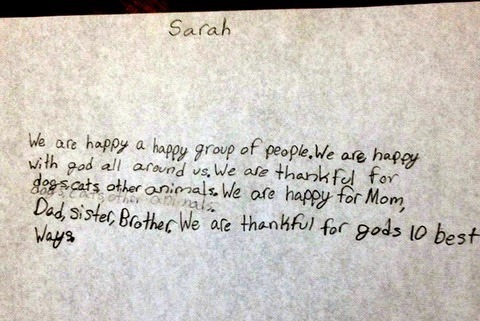
2. Write a psalm showing how you feel today. Draw a picture to go with it.
Or read a psalm to a friend that shows how you feel.
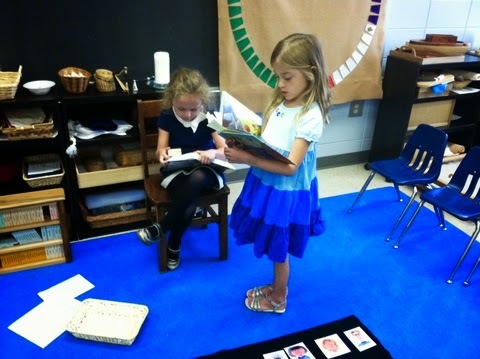
3. Illustrate a Psalm. Choose a psalm and illustrate it, like Arno did in Psalms for Young Children. (Any Psalm would be good. If you want, you could 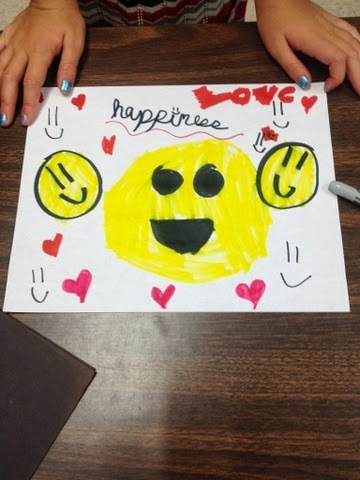 choose the psalm for the children, like #23 or 139.)
choose the psalm for the children, like #23 or 139.)
4. Write a psalm together as a class, and then let the children illustrate it individually or together.
5. Work out a tune that fits a psalm that you like. Or write your own to sing.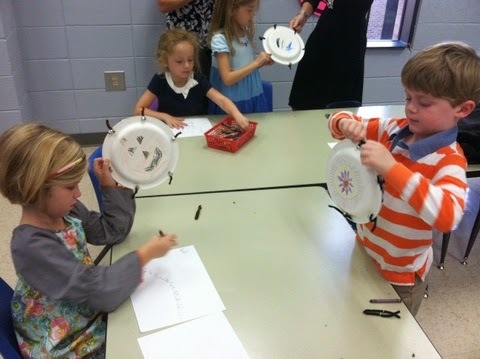 6. Make instruments to play while singing a psalm. You can find directions to make a simple tambourine here, and a lyre here.
6. Make instruments to play while singing a psalm. You can find directions to make a simple tambourine here, and a lyre here.
7. For more ideas, find my Pinterest page on the Psalms here.
Enjoy! [image error]
The post The Psalms appeared first on beckyramsey.info.
October 11, 2021
The Story of David
 Welcome to the story of King David, the Godly Play story scheduled for this Sunday, November 3, based on 1 Samuel 16-31, 2 Samuel and 1Kings 1-2. You can find the script for the story in the pink Enrichment Presentations for Fall book, p.78-85.
Welcome to the story of King David, the Godly Play story scheduled for this Sunday, November 3, based on 1 Samuel 16-31, 2 Samuel and 1Kings 1-2. You can find the script for the story in the pink Enrichment Presentations for Fall book, p.78-85.
Some of the story’s themes which you might want to help the children think about:
1. We can come to God with all sorts of feelings (as in the Psalms—we’ll explore this one more next week)
2.God can help us be brave enough to do what is right and needed.
3. Friendship is a gift from God.
4. God uses people, even with their faults.
5. God forgives our mistakes when we ask for forgiveness.
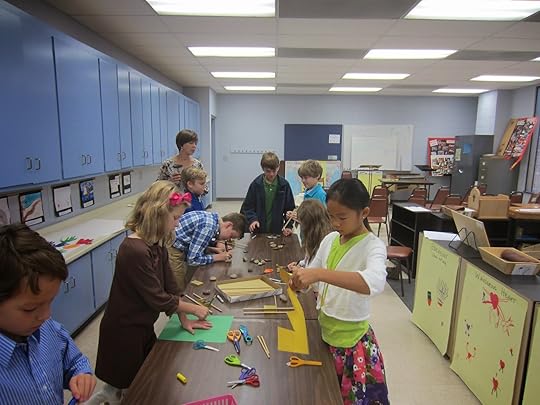 Children choose how to respond to the story and get started!
Children choose how to respond to the story and get started!
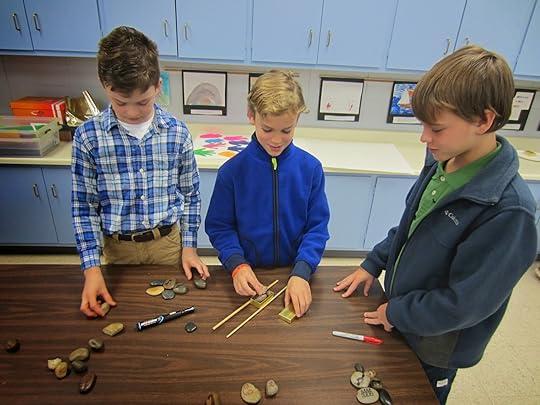 Some children drew symbols of David’s life on stones. You can see another made an ark of the covenant.
Some children drew symbols of David’s life on stones. You can see another made an ark of the covenant.
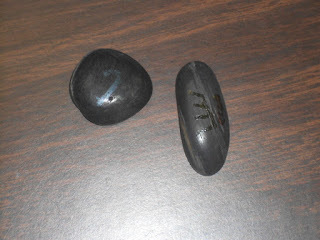 Stones with symbols of David’s life
Stones with symbols of David’s life 1. Children could reproduce the elements of the
story in some way.
* Make a harp
*Make a crown for King David
*Make an ark of the covenant
*Make a parable box for the parable that Nathan told David (there is plenty of felt in the resource room)
*Make a drawing of Jerusalem- or a watercolor.
2. Children could paint symbols of David’s life (shepherd’s crook, bottle of incense, two friends, crown, ark, etc) on small stones. There are stones in the resource room.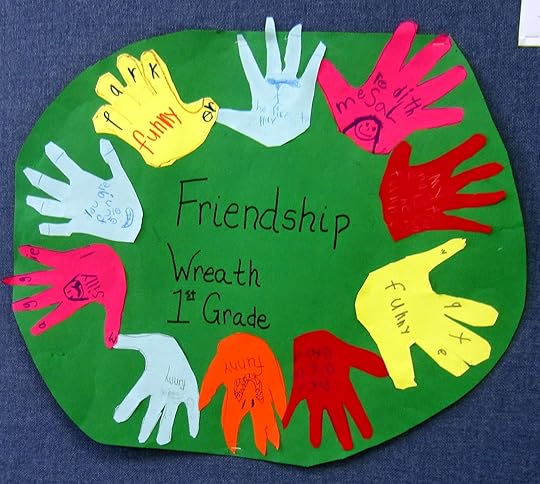
3. Children can celebrate David’s childhood by making David with the sheep. Go to the site here, for plenty of options for crafting sheep. (Scroll down to “sheep”)
4. Children could sculpt a David and Goliath out of play clay.
5. The class could work on a mural of David’s life with one long piece of butcher paper- assigning parts of his life to individual children to illustrate.
6. Children could focus on the friendship between Jonathan and David and explore what kind of friendship God celebrates.
Find more art response ideas at my Pinterest page, here.Enjoy!Love, BeckyThe post The Story of David appeared first on beckyramsey.info.
October 4, 2021
The Story of Samuel
 Welcome to the story of Samuel, based on 1 Samuel 1-28:3. You can find the script for the story in the pink Enrichment Presentations for Fall book, p.72-77.
Welcome to the story of Samuel, based on 1 Samuel 1-28:3. You can find the script for the story in the pink Enrichment Presentations for Fall book, p.72-77.
This week’s story is another one (like Ruth) that fits nicely after the story of the ark and the tent. And it follows right into the next story on our schedule: the story of David.
The story of Samuel is also very interesting to children because they relate to the idea of a child growing physically and in relationship with God and because they think about how God communicates- and might wish that God would call their names in an audible voice.
Themes you might want to help the children think about:
1.God answers prayer
2. You can serve God even as a child.
3.God plans to take care of you. (If you want to use a memory verse, you could use Jeremiah 29:11)
4.God asks us to stand up for what is right, as Samuel did.
5.Obedience (Samuel obeyed God even though he was not happy that the people wanted a king.)
Ideas for the Make a Gift for God time: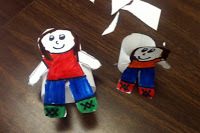 Remember that one of the most important parts of Godly Play is that it gives the child options in how she responds to the story. We want to give children as many chances to have say so in what they do as possible.
Remember that one of the most important parts of Godly Play is that it gives the child options in how she responds to the story. We want to give children as many chances to have say so in what they do as possible.
2. Reproduce the story in some way- make pieces, such as the ark, a Baby Samuel, robes of different sizes, 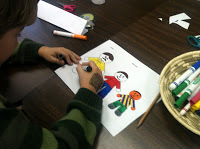 (showing how Samuel grew during his service in the temple), a sleeping mat, a crown
(showing how Samuel grew during his service in the temple), a sleeping mat, a crown
2. Children could make a life size drawing of themselves and caption it: I can serve God right now! This could be done by having another child trace around their body on butcher paper. They could draw clothes on their body or use fabric from the resource room. Maybe they could hold something in the drawing that gives a hint to how they can serve God right now.
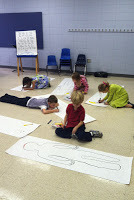
3. A collage or drawing of how children can serve God right now. Children could make these individually and then put them together as a class project. (Ways include how they treat others, through prayer, in worship at church, helping others…)
4. Children could think about how they might like to serve God in the future. How does a doctor or teacher or engineer or scientist serve God? They could explore this in a drawing or make a model with play clay.
5. Children could act out the story of Samuel hearing God’s call and going to Eli–and the rest of the story as well.
6. Hannah makes Samuel a new robe each year and brings it to him in the temple. Children could make a “robe” from a paper grocery bag as we often do with Joseph, as shown here. (Scroll down and see the child modeling hers!)
I can’t wait to see how the children think about this story!
For more art response ideas, see my Pinterest page, here.
Love, Becky
The post The Story of Samuel appeared first on beckyramsey.info.
September 27, 2021
The Story of Ruth
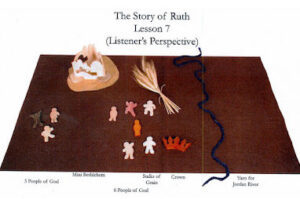 Welcome to the story of Ruth, based on the book of Ruth. You can find the script for the story in the pink Enrichment Presentations for Fall book, p.66-71.
Welcome to the story of Ruth, based on the book of Ruth. You can find the script for the story in the pink Enrichment Presentations for Fall book, p.66-71.
The story of Ruth follows the story of the Tabernacle, in which great emphasis was put on being one of the chosen people of God. It’s wonderful that we now can share the story of Ruth, not one of the chosen People of God, but a Moabite, yet she was clearly valued and loved by God. She married one of God’s People, Boaz, and eventually became the great grandmother of King David (and an ancestor of Jesus!) The story gives us a wonderful opportunity to remind children that God values “other-ness,” that all are included in and welcomed into God’s love and care.
Idea sparkers for the Give a Gift to God time:
There are several ways children and teachers can go with this.
1. Focus on the story itself.
a) Let the children act out the story.
b) Draw the scenes of the story or make a three dimensional representation of the story.
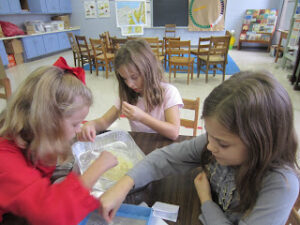 “Fill 2 roasting pans or cookie sheets with 2 lbs. of cornmeal and a cup of rice and place it in the center of the blanket. Set the paper cup to the side. Explain to the children that they will be gleaning grain just as Ruth did for Naomi. Divide the kids into two groups. Have each group stand around their pan. Ask them to work together to fill the cups with rice, one grain at a time. Tell the children not to put any of the rice into their mouths since it is uncooked. For a fun challenge, set a timer for three minutes. Ask the children to see if they can fill the “bushel” before the timer goes off. But remind them to be careful – if someone knocks over the cup they’ll have to start all over again.”
“Fill 2 roasting pans or cookie sheets with 2 lbs. of cornmeal and a cup of rice and place it in the center of the blanket. Set the paper cup to the side. Explain to the children that they will be gleaning grain just as Ruth did for Naomi. Divide the kids into two groups. Have each group stand around their pan. Ask them to work together to fill the cups with rice, one grain at a time. Tell the children not to put any of the rice into their mouths since it is uncooked. For a fun challenge, set a timer for three minutes. Ask the children to see if they can fill the “bushel” before the timer goes off. But remind them to be careful – if someone knocks over the cup they’ll have to start all over again.”
d) Let the children explore wheat. Give each child a single spear (I bought some from Hobby Lobby in the dried flower section) and let them try to separate the grains. Let me know by Tuesday if you’d like me to buy some wheat for your class.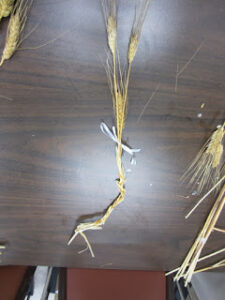
e) Weave wheat into an ornament/hanging as described here.
2. Focus on friendship between Ruth and Naomi.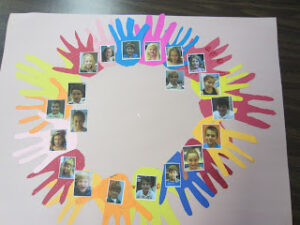
You can concentrate on the theme that friendship and the loyalty that goes with it is a gift from God. a) Children might make friendship bracelets, like those shown here. Or for younger children, make simple strings of beads made into bracelets. We have tons of material for these in the art storage room! Or make a necklace for a friend, as shown here.
b) Children could make a mural together of what it means to be a friend- what friends do for each other. Each child could work individually or in pairs- and put the works together as a mural or for a bulletin board in your classroom.
c) Make a Friendship wreath for your classroom, as shown here.
d) Examine the song, “Blessed Be the Tie That Binds” and let the children illustrate it.
3. Focus on God welcoming all people.
a) How are we welcoming to others who might be different? Children could make a collage for “God Loves Everyone”
b) Make a God’s Love Note for a friend- like the ones shown here.
For more ideas, see my Pinterest Page on the Ruth, here.
The post The Story of Ruth appeared first on beckyramsey.info.

